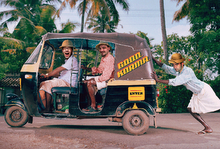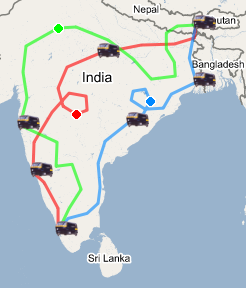1 Week's Worth of Insight
There are some "truths" about India. At least the southern half that we've traversed. India is such a completely foreign experience for us that it was at once overpowering. Every fundamental detail in the day to day living is different from our regular lives. Sure if you are staying at a tourist resort and getting shuttled around in a nice Range Rover, you aren't too far off from your familiar world. That's not what we are doing. Driving an autorickshaw, the poorman's cab, and staying in working class or poor towns is another thing all together. Living and traveling this way, you are at once overwhelmed with what you see, hear, touch, taste and most importantly - smell. After some days of it, you become numb to the small details, as say, monkey's picking through your hotel trash or a family of 5 on a moped. You begin to see patterns in the chaos. The sweeping changes from region to region fall away from your perception and the Indian Universal Truths appear.
1) Everyone "Bobbles"
I don't know if there is a culturally correct term for the side to side, fluid "bobble" that you see on man, woman and child. The smallest child seems to perfect the technique before they can do much else on their own. The "bobble" defies definition but can be thought of as a modifier and physical representation of the bobbler's state of mind. It frosts the cake of whatever the bobbler is expressing or feeling.
If the person is waving hello or goodbye and smiling - the enthusiastic "bobble" means, "Look, I'm so happy my head is waving too."
If in response to a question in English and accompanied by a downward look or shy smile - it means, "I have no idea what this foreign jibberish is, maybe this person will go way."
If it comes with a half-hearted reply to a request, it means "I am going to stall because I don't want to do what this person is asking of me" or "I'd rather not admit that I don't know where the post office is, so I'll just say 1 kilometer that way."
2) There Are No Sidewalks In India
Sure in the cities there are some things that you might at first think are sidewalks. They are hardly used as they are actually only brief covers over the open sewer running along both sides of every road. They often occur only in front of a shop and often then only in front of the doorway. Outside of the larger towns, these small ramps are sometimes only plywood keeping you up out of a village worth of waste.
As a result, if you are a mobile creature or object, you must use the roadway. There are few rules to moving around the streets both in cities and the countryside. You should try to stay towards the left, but the concept of "left" is really arguable. Who's left are we talking about anyway? Also there is no minimum or maximum speed. Obviously if you are an ox cart loaded with a 50 foot tower of bamboo you aren't going to go as fast as a TATA SUV (trust me, it's a car brand here). Likewise barefooted pilgrims on the 38th kilometer of their journey can't really get along like a bus loaded to the roof. Of course, if you get tired, you should just lay down. The road is a fine place for people or animals to sleep or conduct whatever business is needed. Also size equals right-of-way. If you are big, just honk and move where you desire. Everyone else will fall out of the way. If you are in a hurry, don't bother honking. Also everyone knows that headlights are for flashing at someone coming straight for you. Don't bother to keep them on the rest of the time. You'll probably just drain your battery.
Things we've seen on the roadway: people walking, people sleeping, people relieving themselves, buses, trucks, SUVs, Jeeps, auto rickshaws, mopeds, motorcycles, bicycles, ox carts, herds of goats, chickens, monkeys, water buffalo, elephants, cows, dogs, cats, mongooses, pigs, oxen, quail, bald eagles, and cats. Bikes, mopeds or pull carts might be loaded with crates of live ducks, plastic jugs, live chickens tied by their feet, hay, bamboo, or an extended family.
3) Holding It In Is Bad
If you are on the road in India and you feel the need to expel something from your body - solid or liquid, regardless of orifice - you should just get it out. Immediately. Right were you are standing.
Some people attempt to direct their "leavings" in the general direction of the open sewer, but this is not universally followed and in no way required. Certainly this doesn't apply to animals or children.
There are some things to consider in some cases. Really only to increase the "effect" of your "release".
For instance, if you are the 227th person on a 40 capacity bus and the bumpy ride in the overhead compartment has left you nauseous, you will need to open a window to get to the roadway. Just prior to vomiting, consider if there is an autorickshaw passing your bus at that moment. It would be quite impressive to actually "hit" the rickshaw and may help to settle your stomach and make you feel better. This takes some skill to accomplish though, so don't feel bad if you miss on the first try. Of the 4 attempts we've had this past week, only 1 has been successful.
4)Mountains of Roadside Trash are Neutral Zones.
There is a widely accepted rule that if you are picking through the trash looking for a snack or settling down for a nap, everyone is equal. Past grievances must be put aside. Monkeys can graze with dogs and cats. Ox can nibble with people sleeping. Pigs can root around next to goats or crows and nary a look should be given.
5) If It Burns, Burn It.
The proper way to dispose of something is to toss it from your person. Eventually everything flung about will gather naturally in to great heaps every few feet or in the open sewer. Periodically someone should scoop out the chunks in the sewer and load them on top of the trash hills. Every other pile of refuse should be on fire. Especially if they are composed of plastic bottles, fecal matter, old tires and styrofoam, as most are.
6) Living Things Can't Really Be Owned
Sure that herd of goats is "yours", but really that is just legal semantics. All animals should be roaming free. Chickens, cows, goats, dogs, cats, oxen, water buffalo, etc. will fend for themselves. Just let them run about and periodically check in on them. A piece of rope around thier neck means they they are a domestic animal "belonging" to someone and only need to be given a small berth. If there is no rope, you should stay a good biting or goring distance away. This applies to the city as much as the countryside. If your goats wander onto a 4 lane highway or into a busy urban intersection, people will move out of the way. Don't worry. Sure you can have an ox in your apartment complex. He'll sleep out front on the street next to the dogs, chickens and goats.
This is some of what we've learned so far. More Indian Universal Truths will emerge, we're sure. This is only week 1 after all.
Anthony //
Tuesday, January 2, 2007
Subscribe to:
Post Comments (Atom)


No comments:
Post a Comment